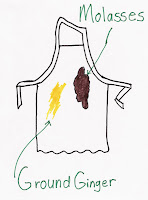I’m a big fan of the idea of a dinner with a movie theme. Somehow, I rarely get something like that together, but now that it’s Christmas vacation, the time and the opportunity presented themselves. This is a laid-back dinner for a laid-back Christmas movie, one of my favorites. I wanted a fairly quick and easy meal, and I wanted to watch A Christmas Story. Even though the Bumpus’ dogs hadn’t stolen my turkey, and I wouldn’t be having a Peking duck smiling at me while Chinese waiters sang “Fa Ra Ra Ra Ra,” it still seemed appropriate to serve a spicy chicken stir fry while watching Ralphie pine for a Red Ryder B B gun (with a compass in the stock and this thing which tells time).
The secret to stir fry is much like the secret to a serene holiday season: prepare as much ahead of time as possible. Do I succeed in this? With stir fries, usually. I cook the rice, marinate the chicken, prepare the sauce, and chop everything else before even thinking about heating the wok. My holiday preparations are a completely different story. (Exhibit A: fewer than usual posts this month.) Oh well, as I always say, next year will be different.
So light your leg lamp and fire up your wok (or a large frying pan) and cook up a spicy chicken stir fry for a pre-Christmas celebration. Just don’t stick your tongue to any flag poles for old time’s sake. And if you do, please don’t bother the fire department. A simple glass of warm water poured over the offending area will solve the problem. Am I speaking from experience? I’ll never admit it. Oh, yeah, and don’t shoot your eye out.
This is based on Sichuan or Kung Pao chicken dishes in Chinese restaurants. If you cannot find whole water chestnuts, sliced ones will be fine. Serve with hot cooked rice and a pot of tea.
½ cup fat-free, less-sodium chicken broth
2 tablespoons honey
¼ cup soy sauce
¼ cup Shaoxing wine (or sake)
2 tablespoons Chinese black vinegar (or rice vinegar)
2 teaspoons cornstarch
2 teaspoons dark sesame oil
1 pound boneless skinless chicken breast, cut into bite-size pieces
1 bunch (about 8 medium) green onions
1 large (or 2 small) red bell pepper
1 (8-ounce) can whole water chestnuts
3 tablespoons canola oil or peanut oil, divided
1 ½ tablespoon minced peeled fresh ginger
1 ½ tablespoon minced garlic (about 5-7 cloves)
4-6 dried chile peppers
½ cup cashews
1. Combine the chicken broth, honey, soy sauce, Shaoxing wine, Chinese black vinegar, cornstarch and sesame oil in a small bowl. Whisk well to combine.
2. Place the chicken in a medium bowl. Remove ¼ cup of the broth mixture and pour it onto the chicken. Stir well to coat the chicken. Set aside to marinate for 20-30 minutes. (If the chicken will be standing longer than that, refrigerate it until ready to use.)
3. Cut off the roots of the green onions and thinly slice the white and light green part. Set aside. Cut the dark green tops into 1-inch lengths. Set aside separately. Cut the bell pepper into approximately 1-inch squares. Halve the water chestnuts (quarter the larger ones).
4. Heat 2 tablespoons oil in a wok or large skillet over high heat until it appears to shimmer. Add the ginger, garlic and dried chiles. Stir fry (ie, cook while stirring constantly) 30 seconds. These ingredients can produce acrid fumes when heated like this, so avoid inhaling those fumes if possible.
7. Return the chicken to the pan and add the sauce. Bring to a boil and cook until the sauce has thickened slightly. Turn off the heat and stir in the green onion tops and cashews. Serve with hot cooked rice.
Makes 4 servings.










